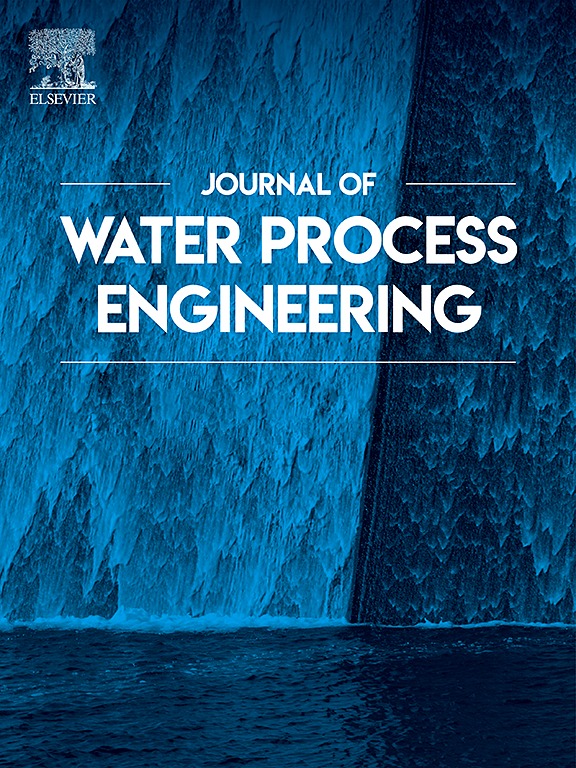Design MOFs functional magnetic composite for adsorption removal and sensitive detection of bisphenols in environmental and food samples
IF 6.7
2区 工程技术
Q1 ENGINEERING, CHEMICAL
引用次数: 0
Abstract
As a typical endocrine disruptor, bisphenols have been shown to cause some degree of damage to human immunity, reproductive development, and the nervous system. Currently, bisphenols in aquatic environments and plastic packaged foods have become the major source of human exposure to bisphenols. However, monitoring and adsorptive removal of bisphenols has been a challenge due to the complexity of the matrix and the low content of bisphenols. In this study, Fe3O4/UiO-66-C/SA was developed, having the merits of high specific surface area, suitable pore size, good chemical stability, and magnetic properties. Thus, based on this material, A magnetic solid phase extraction coupled with high-performance liquid chromatography (MSPE-HPLC) method was established for the analysis of bisphenols in environmental water and beverage samples. The extraction parameters were thoroughly examined. The developed method exhibited good linear range (r > 0.99), detection limit (0.022–0.054 ng mL−1), accuracy (71.3–99.9 %), and reproducibility (RSD < 8.5 %). Furthermore, the Fe3O4/UiO-66-C/SA was employed as a sorbent for the adsorptive removal of bisphenols. The adsorption kinetic and adsorption isotherm were analyzed. The adsorption of BPs was a chemisorption-dominated process with the adsorption of multimolecular layers. This work provided an effective material for adsorption removal of bisphenols in the environment and analysis of bisphenols in the environmental and food samples.
设计用于吸附去除和灵敏检测环境和食品样品中双酚的 MOFs 功能磁性复合材料
作为一种典型的内分泌干扰物,双酚已被证明会对人体免疫力、生殖发育和神经系统造成一定程度的损害。目前,水生环境和塑料包装食品中的双酚已成为人类接触双酚的主要来源。然而,由于基质的复杂性和双酚的低含量,监测和吸附去除双酚一直是一项挑战。本研究开发的 Fe3O4/UiO-66-C/SA 具有高比表面积、合适的孔径、良好的化学稳定性和磁性等优点。因此,基于该材料建立了一种磁性固相萃取-高效液相色谱(MSPE-HPLC)方法,用于分析环境水和饮料样品中的双酚。对萃取参数进行了全面考察。所建立的方法具有良好的线性范围(r 为 0.99)、检出限(0.022-0.054 ng mL-1)、准确度(71.3-99.9%)和重现性(RSD 为 8.5%)。此外,Fe3O4/UiO-66-C/SA 被用作吸附去除双酚的吸附剂。分析了吸附动力学和吸附等温线。双酚的吸附是一个多分子层吸附的化学吸附主导过程。这项工作为吸附去除环境中的双酚以及分析环境和食品样品中的双酚提供了一种有效的材料。
本文章由计算机程序翻译,如有差异,请以英文原文为准。
求助全文
约1分钟内获得全文
求助全文
来源期刊

Journal of water process engineering
Biochemistry, Genetics and Molecular Biology-Biotechnology
CiteScore
10.70
自引率
8.60%
发文量
846
审稿时长
24 days
期刊介绍:
The Journal of Water Process Engineering aims to publish refereed, high-quality research papers with significant novelty and impact in all areas of the engineering of water and wastewater processing . Papers on advanced and novel treatment processes and technologies are particularly welcome. The Journal considers papers in areas such as nanotechnology and biotechnology applications in water, novel oxidation and separation processes, membrane processes (except those for desalination) , catalytic processes for the removal of water contaminants, sustainable processes, water reuse and recycling, water use and wastewater minimization, integrated/hybrid technology, process modeling of water treatment and novel treatment processes. Submissions on the subject of adsorbents, including standard measurements of adsorption kinetics and equilibrium will only be considered if there is a genuine case for novelty and contribution, for example highly novel, sustainable adsorbents and their use: papers on activated carbon-type materials derived from natural matter, or surfactant-modified clays and related minerals, would not fulfil this criterion. The Journal particularly welcomes contributions involving environmentally, economically and socially sustainable technology for water treatment, including those which are energy-efficient, with minimal or no chemical consumption, and capable of water recycling and reuse that minimizes the direct disposal of wastewater to the aquatic environment. Papers that describe novel ideas for solving issues related to water quality and availability are also welcome, as are those that show the transfer of techniques from other disciplines. The Journal will consider papers dealing with processes for various water matrices including drinking water (except desalination), domestic, urban and industrial wastewaters, in addition to their residues. It is expected that the journal will be of particular relevance to chemical and process engineers working in the field. The Journal welcomes Full Text papers, Short Communications, State-of-the-Art Reviews and Letters to Editors and Case Studies
 求助内容:
求助内容: 应助结果提醒方式:
应助结果提醒方式:


